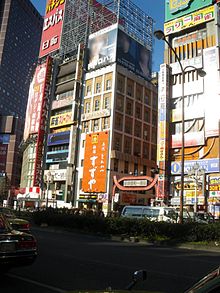Kabukichō
Kabukichō (Japanese: 歌舞伎町, transleet. Kabuki-chō, [ka̠bɯ̟ᵝkʲi t͡ɕo̞ː]) is an enterteenment an reid-licht destrict in Shinjuku, Tokyo, Japan. Kabukichō is the location o mony hostess bars, host bars, love hotels, shops, restaurants, an nichtclubs, an is aften cried the "Sleepless Toun" (眠らない街). The destrict's name comes frae late-1940s plans tae build a kabuki theater. Awtho the theater wis niver built, the name stuck.
The aurie haes mony movie theaters, an is locatit near Shinjuku Station, Seibu Shinjuku Station, an several ither major railway an subway stations.
History
[eedit | eedit soorce]Oreeginally, the aurie wis kent as Tsunohazu (角筈) an wis a swamp. Efter the Meiji Period, the aurie became a duck sanctuar. As the Yodobashi Purification Plant wis built in 1893, the ponds were filled in. In 1920, a girl's schuil wis built there, and the surroundings wur developit intae a residential aurie. Durin Warld War II, the bombin o Tokyo in 1945 razit the aurie tae the grund. Efter the war, a kabuki theatre wis planned tae be built thare an the toun changit its name tae Kabukichō. Though the theatre wis cancelled due tae financial problems, the name remained. Kabukichō wis quickly redevelopit efter the war, mainly due tae the efforts o the owerseas Cheenese in Japan who bocht laund left unuised efter the expos an greatly developit them. Examples o such fowk include the foonder o Humax, Lin Yiwen, wha stairtit his business wi a cabaret.
At present, Kabukichō haes transformit frae a residential aurie tae a warld famous red-licht destrict hoosin ower three thoosan bars, nichtclubs, love hotels, massage parlours, hostess clubs an the like. Awtho referred here as a "reid licht destrict", thare are nae red lichts in the literal sense wi prostitutes in the windaes as in Amsterdam. Recently, tourism frae Cheenae an Korea are on the rise, an so, mony tourists can be seen in Kabukichō even durin daytime.
Creeme
[eedit | eedit soorce]
Accordin tae a spokesperson o Metropolitan Tokyo in 2004, there are mair nor 1,000 yakuza members in Kabukichō, an 120 different enterprises unner their control.[1]
Enterin the new millennium, laws wur mair strictly enforcit an patrols became mair frequent. These, addin tae the installation o fifty closed-circuit cameras in Mey 2002, reducit creeminal activities in Kabukichō, amidst controversy.
In 2004, the polis unnerteuk an operation clampin doun on illegal clubs an bordels, causin mony tae go oot o business. An aw, thare is a muivement tae rid Kabukichō o the yakuza ("bad haund" gangs), kent as the Kabukichō Renaissance.
In cultur
[eedit | eedit soorce]Kabukichō is featurt in a nummer o media:
- Shinjuku Incident, a 2009 Jackie Chan movie set in the early '90s aboot Cheenese immigrants in Japan
- Fuyajo, novel bi Hase Seishu. An aw, a movie based on the novel that wis filmit in Kabukichō[2]
- Enter the Void, a film bi Gaspar Noé, wis pairtly filmit an set in Kabukichō[3]
- A Guide of the Sleepless Town, novel bi Lee Xiaomu
- TOKYO REALTIME: Kabukicho Archived 2022-05-21 at the Wayback Machine, an audio guidit tour o Kabukicho producit bi Max Hodges
- In the Miso Soup, novel bi Ryu Murakami
- Dreaming Pachinko, novel bi Isaac Adamson
- "Kabukichō No Joō", sang bi Shiina Ringo
- The School of Water Business, novel bi Hikaru Murozumi
- Shin Megami Tensei: Nocturne, a role-playin video game bi Atlus
- Yakuza series, an Action-adventur gemme bi Sega featurs a fictionalizit Kabukichō as Kamurocho
- Ugly Americans, novel bi Ben Mezrich
- Pattern Recognition, novel bi William Gibson
- "Shin Pet Shop of Horrors", manga bi Matsuri Akino
- The manga Gintama by Hideaki Sorachi is mostly focused around a fictional version of Kabukichou in the late 19th century
- Tokyo Vice, beuk bi Jake Adelstein
-
Ane o the entrances tae Kabukichō
-
Bricht lichts o Kabukichō
See an aw
[eedit | eedit soorce]References
[eedit | eedit soorce]- ↑ 2004年1月19日竹花東京都副知事発言・歌舞伎町住民との懇談会
- ↑ "IMDB entry on the movie "Fuyajō"".
- ↑ "Interview with Gaspar Noé for the A.V. club".
Freemit airtins
[eedit | eedit soorce]- Kabukicho Renaissance offeecial wabsteid - Kabukicho toun information - Archived 2010-08-04 at the Wayback Machine (in Inglis)
- KABUKI町 Kabukicho ptal site (in Japanese)
- Kabukicho Commune Archived 2009-10-12 at the Wayback Machine (in Japanese)
- @GEHA Kabukicho Renewal Alliance (in Japanese)
- Kabukicho Renaissance blog,Koichi Teratani, a documentary maker and authority on Kabukicho Archived 2012-03-20 at the Wayback Machine (in Japanese)
Coordinates: 35°41′38″N 139°42′12″E / 35.69388°N 139.703422°E


